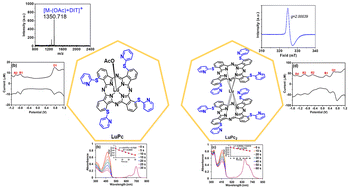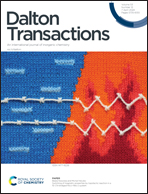Novel non-peripheral mercaptopyridine-substituted mono- and double-decker lutetium(iii) phthalocyanines: synthesis, photophysicochemical and electrochemical properties†
Abstract
In this study, novel non-peripheral tetra-mercaptopyridine-substituted mono- and double-decker phthalocyanines (LuPc and LuPc2) containing lutetium(III) as a rare earth metal were synthesized and characterized using different spectroscopic techniques. ESR and electrochemical analyses were performed to support the sandwich structure of LuPc2. The g factor was determined to be 2.00039 and the characteristic first reduction couple at 0.29 V indicated a reduction of the radical Pc ring of LuPc2. In addition, the UV-Vis-NIR spectra of LuPc2 in neutral, reduced, and oxidized states demonstrate its intrinsic π-radical nature in CHCl3. The photophysicochemical properties of LuPc and LuPc2 were investigated in DMSO. It was found that mono-phthalocyanine (LuPc) is a more effective photosensitizer than double-decker (LuPc2) and metal-free (H2Pc) phthalocyanines based on a comparison of their photophysical and photochemical properties. The singlet oxygen quantum yields (ΦΔ) of the synthesized LuPc and LuPc2 compounds were calculated to be 0.57 and 0.14, respectively, and the obtained results were compared with H2Pc (ΦΔ = 0.04). Also, electrochemical measurements were performed to estimate their redox potentials and the results indicated the important electrochemical performance of double-decker phthalocyanine (LuPc2).



 Please wait while we load your content...
Please wait while we load your content...